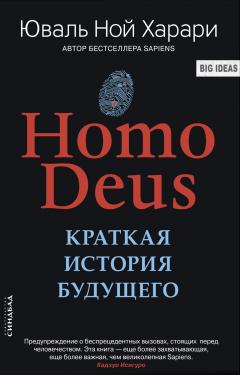Юваль Ной Харари - Sapiens. Краткая история человечества

Помощь проекту
Sapiens. Краткая история человечества читать книгу онлайн
1
Ann Gibbons, ‘Food for Thought: Did the First Cooked Meals Help Fuel the Dramatic Evolutionary Expansion of the Human Brain?’, Science 316:5831 (2007), 1558-1560.
2
Robin Dunbar, Groomingy Gossipy and the Evolution of Language (Cambridge, Mass.: Harvard University Press, 1998).
3
Michael L. Wilson and Richard W. Wrangham, ‘Intergroup Relations in Chimpanzees’, Annual Review of Anthropology 32 (2003), 363-392; M. McFarland Symington, ‘Fission-Fusion Social Organization in Ateles and Pan у International Journal of Primatologyy 11:1 (1990), 49; Colin A. Chapman and Lauren J. Chapman, ‘Determinants of Groups Size in Primates: The Importance of Travel Costs’, in On the Move: How and Why Animals Travel in Groups, ed. Sue Boinsky and Paul A. Garber (Chicago: University of Chicago Press, 2000), 26.
4
Dunbar, Groomingy Gossip, and the Evolution of Languagey 69-79; Leslie C. Aiello and R. I. M. Dunbar, ‘Neocortex Size, Group Size, and the Evolution of Language’, Current Anthropology 34:2 (1993), 189. Критику этого подхода см.: Christopher McCarthy et al., ‘Comparing Two Methods for Estimating Network Size’, Human Organization 60:1 (2001), 32; R. A. Hill and R. I. M. Dunbar, ‘Social Network Size in Humans’, Human Nature 14:1 (2003), 65.
5
Yvette Taborin, ‘Shells of the French Aurignacian and Perigordian’, in Before Lascaux: The Complete Record of the Early Upper Paleolithic, ed. Heidi Knecht, Anne Pike-Тау and Randall White (Boca Raton: CRC Press, 1993), 211-228.
6
G.R. Summerhayes, ‘Application of PIXE-PIGME to Archaeological Analysis of Changing Patterns of Obsidian Use in West New Britain, Papua New Guinea’, in Archaeological Obsidian Studies: Method and Theory, ed. Steven M. Shackley (New York: Plenum Press, 1998), 129-158.
7
Christopher Ryan and Cacilda Jetha, Sex at Dawn: The Prehistoric Origins of Modern Sexuality (New York: Harper, 2010).
8
Noel G. Butlin, Economics and the Dreamtime: A Hypothetical History (Cambridge: Cambridge University Press, 1993), 98-101; Richard Broome, Aboriginal Australians (Sydney: Allen & Unwin, 2002), 15; William Howell Edwards, An Introduction to Aboriginal Societies (Wentworth Falls, N.S.W.: Social Science Press, 1988), 52.
9
Fekri A. Hassan, Demographic Archaeology (New York: Academic Press, 1981), 196-199; Lewis Robert Binford, Constructing Frames of Reference: An Analytical Method for Archaeological Theory Building Using Hunter Gatherer and Environmental Data Sets (Berkeley: University of California Press, 2001), 143.
10
Paul Seabright, The Company of Strangers: A Natural History of Economic Life (Princeton: Princeton University Press, 2004), 261 n. 2; M. Henneberg and M. Steyn, ‘Trends in Cranial Capacity and Cranial Index in Subsaharan Africa During the Holocene’, American Journal of Human Biology 5:4 (1993): 473-479.
11
Nicholas G. Blurton Jones et al., ‘Antiquity of Postreproductive Life: Are There Modern Impact on Hunter-Gatherer Postreproductive Life Spans?’, American Journal of Human Biology 14 (2002), 184-205.
12
Kim Hill and A. Magdalena Hurtado, Ache Life History: The Ecology and Demography of a Foraging People (New York: Aldine de Gruyter, 1996), 164,236.
13
Hill and Hurtado, Ache Life History, 78.
14
Vincenzo Formicola and Alexandra P. Buzhilova, ‘Double Child Burial from Sunghir (Russia): Pathology and Inferences for Upper Paleolithic Funerary Practices’, American Journal of Physical Anthropology 124:3 (2004), 189-198; Giacomo Giacobin£ ‘Richness and Diversity of Burial Rituals in the Upper Paleolithic’, Diogenes 54:2 (2007), 19-39.
15
I.J.N. Thorpe, ‘Anthropology, Archaeology, and the Origin of Warfare’, World Archaology 35:1 (2003), 145-165; Raymond C. Kelly, Warless Societies and the Origin of War (Ann Arbor: University of Michigan Press, 2000); Azar Gat, War in Human Civilization (Oxford: Oxford University Press, 2006); Lawrence H. Keeley, War before Civilization: The Myth of the Peaceful Savage (Oxford: Oxford University Press, 1996); Slavomil Vend, ‘Stone Age Warfare’, in Ancient Warfare: Archaeological Perspectives, ed. John Carman and Anthony Harding (Stroud: Sutton Publishing, 1999), 57-73.
16
James F. O’Connel and Jim Allen, ‘Pre-LGM Sahul (Pleistocene Australia — New Guinea) and the Archeology of Early Modern Humans’, in Rethinking the Human Revolution: New Behavioural and Biological Perspectives on the Origin and Dispersal of Modern Humans, ed. Paul Mellars, Ofer Bar- Yosef, Katie Boyle (Cambridge: McDonald Institute for Archaeological Research, 2007), 395-410; James F. O’Connel and Jim Allen, ‘When Did Humans First Arrived in Grater Australia and Why Is It Important to Know?’, Evolutionary Anthropology 6:4 (1998), 132-146; James E O’Connel and Jim Allen, ‘Dating the Colonization of Sahul (Pleistocene Australia — New Guinea): A Review of Recent Research’, Journal of Radiological Science 31:6 (2004), 835-853; Jon M. Erlandson, ‘Anatomically Modern Humans, Maritime Voyaging, and the Pleistocene Colonization of the Americas’, in The first Americans: the Pleistocene Colonization of the New World, ed. Nina G. Jablonski (San Francisco: University of California Press, 2002), 59-60, 63-64; Jon M. Erlandson and Torben C. Rick, Archeology Meets Marine Ecology: The Antiquity of Maritime Cultures and Human Impacts on Marine Fisheries and Ecosystems’, Annual Review of Marine Science 2 (2010), 231— 251; Atholl Anderson, ‘Slow Boats from China: Issues in the Prehistory of Indo-China Seafaring’, Modern Quaternary Research in Southeast Asia, 16 (2000), 13-50; Robert G. Bednarik, ‘Maritime Navigation in the Lower and Middle Paleolithic’, Earth and Planetary Sciences 328 (1999), 559-560; Robert G. Bednarik, ‘Seafaring in the Pleistocene’, Cambridge Archaeological Journal 13:1 (2003), 41-66.
17
Timothy F. Flannery, The Future Eaters: An Ecological History of the Australasian Lands and Peoples (Port Melbourne, Vic.: Reed Books Australia, 1994); Anthony D. Barnosky et al., ‘Assessing the Causes of Late Pleistocene Extinctions on the Continents’, Science 306:5693 (2004): 70- 75; Bary W. Brook and David M. J. S. Bowman, ‘The Uncertain Blitzkrieg of Pleistocene Megafauna’, Journal of Biogeography 31:4 (2004), 517-523; Gifford H. Miller et al., ‘Ecosystem Collapse in Pleistocene Australia and a Human Role in Megafaunal Extinction’, Science 309:5732 (2005), 287-290; Richard G. Roberts et al., ‘New Ages for the Last Australian Megafauna: Continent Wide Extinction about 46,000 Years Ago’, Science 292:5523(2001), 1888-1892
18
Stephen Wroe and Judith Field, ‘A Review of Evidence for a Human Role in the Extinction of Australian Megafauna and an Alternative Explanation, Quaternary Science Reviews 25:21-22 (2006), 2692-2703; Barry W. Brooks et al., ‘Would the Australian Megafauna Have Become Extinct If Humans Had Never Colonised the Continent? Comments on “A Review of the Evidence for a Human Role in the Extinction of Australian Megafauna and an Alternative Explanation” by S. Wroe and J. Field’, Quaternary Science Reviews 26: 3-4 (2007), 560-564; Chris S. M. Turney et al., ‘Late-Surviving Megafauna in Tasmania, Australia, Implicate Human Involvement in their Extinction, Proceedings of the National Academy of Sciences 105:34 (2008), 12150-12153.
19
John Alroy, ‘A Multispecies Overkill Simulation of the End-Pleistocene Megafaunal Mass Extinction, Science, 292:5523 (2001), 1893-1896; O’Connel and Allen, ‘Pre-LGM Sahul’, 400-401.
20
L.H. Keeley, ‘Proto-Agricultural Practices Among Hunter-Gatherers: A Cross-Cultural Survey’, in Last Hunters, First Farmers: New Perspectives on the Prehistoric Transition to Agriculture, ed. T. Douglas Price and Anne Birgitte Gebauer (Santa Fe, N.M.: School of American Research Press, 1995), 243-272; R. Jones, ‘Firestick Farming’, Australian Natural History 16 (1969), 224-228.
21
David J. Meltzer, First Peoples in a New World: Colonizing Ice Age America (Berkeley: University of California Press, 2009).
22
Paul L. Koch and Anthony D. Barnosky, ‘Late Quaternary Extinctions: State of the Debate, The Annual Review of Ecology Evolution, and Systematics 37 (2006), 215-250; Anthony D. Barnosky et al., Assessing the Causes of Late Pleistocene Extinctions on the Continents’, 70-75.
23
Azar Gat, War in Human Civilization (Oxford: Oxford University Press, 2006), 130-131.
24
Katherine A. Spielmann, A Review: Dietary Restriction on Hunter- Gatherer Women and the Implications for Fertility and Infant Mortality’, Human Ecology 17:3 (1989), 321-345. See also: Bruce Winterhalder and Eric Alder Smith, Analyzing Adaptive Strategies: Human Behavioral Ecology at Twenty Five’, Evolutionary Anthropology 9:2 (2000), 51-72.
25
Alain Bideau, Bertrand Desjardins and Hector Perez-Brignoli (eds.), Infant and Child Mortality in tde Past (Oxford: Clarendon Press, 1997); Edward Anthony Wrigley et al., English Population History from Family Reconstitution, 1580-1837 (Cambridge: Cambridge University Press, 1997), 295-296, 303.
26
Manfred Heun et al., ‘Site of Einkorn Wheat Domestication Identified by DNA Fingerprints’, Science 278:5341 (1997), 1312-1314.
27
Charles Patterson, Eternal Treblinka: Our Treatment of Animals and the Holocaust (New York: Lantern Books, 2002), 9-10; Peter J. Ucko and G.W. Dimbleby (ed.), The Domestication and Exploitation of Plants and Animals (London: Duckworth, 1969), 259.
28
Avi Pinkas (ed.), Farmyard Animals in Israel — Researchy Humanism and Activity (Rishon Le-Ziyyon: The Association for Farmyard Animals, 2009 [Hebrew]), 169-199; “Milk Production — the Cow” [Hebrew], The Dairy Council, accessed March 22, 2012, http://www.milk.org.il/cgi-webaxy/sal/Sal.pl?lang=he&ID=645657_milk&act=show&dbid=katavot&dataid=cow.htm.
29
Edward Evan Evans-Pritchard, The Nuer: A Description of the Modes of Livelihood and Political Institutions of a Nilotic People (Oxford: Oxford University Press, 1969); E.C. Amoroso and P.A. Jewell, ‘The Exploitation of the Milk-Ejection Reflex by Primitive People’, in Man and Cattle: Proceedings of the Symposium on Domestication at the Royal Anthropological Institute, 24-26 May 1960, ed. A.E. Mourant and F.E. Zeuner (London: The Royal Anthropological Institute, 1963), 129-134.
30
Johannes Nicolaisen, Ecology and Culture of the Pastoral Tuareg (Copenhagen: National Museum, 1963), 63.
31
Angus Maddison, The World Economy, vol. 2 (Paris: Development Centre of the Organization of Economic Co-operation and Development, 2006), 636; “Historical Estimates of World Population”, U.S. Census Bureau, accessed December 10, 2010, http://www.census.gov/ipc/www/worldhis. html.
32
Robert B. Mark, The Origins of the Modern World: A Global and Ecological Narrative (Lanham, MD: Rowman & Littlefield Publishers, 2002), 24.
33
Raymond Westbrook, ‘Old Babylonian Period’, in A History of Ancient Near Eastern Lawy vol. I, ed. Raymond Westbrook (Leiden: Brill, 2003), 361-430; Martha T. Roth, Law Collections from Mesopotamia and Asia Minor, 2nd ed. (Atlanta: Scholars Press, 1997), 71-142; M. E. J. Richardson, Hammurabis Laws: Text, Translation and Glossary (London: T&T Clark International, 2000).
34
Roth, Law Collections from Mesopotamia, 76.
35
Roth, Law Collections from Mesopotamia, 121.
36
Roth, Law Collections from Mesopotamia, 122-123.
37























